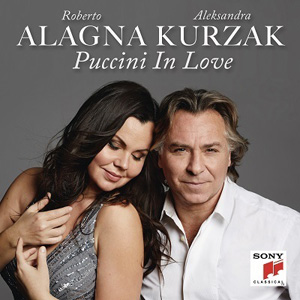While I cannot imagine anyone actually needing this CD, it has some pleasures to offer. Roberto Alagna, once the Wunderkind, so-called Fourth Tenor, never quite reached that stage of either glory or renown (or vulgarity), but for more than two decades he has, in fact, been a household name to opera lovers. His generous performances—never holding back, always singing with a certain grandeur and invariably handsome tone—have made up for a technique that often fails him in the so-called “money notes”. He often cracks or goes south on B-flats or B-naturals, and I don’t believe he attempts a high C in public very much.
At any rate, on this CD he is joined by his youngish wife, Aleksandra Kurzak, in a series of 10 duets from seven Puccini operas. (In the accompanying booklet, Alagna tells us that all the female characters represent different sides of Puccini’s idealized women and the tenors are Puccini himself. He goes on to say that “all his couples could be one and the same couple.” I read it so you need not.) Kurzak is a lovely singer who has been singing bel canto operas very successfully for more than a decade. This Puccini stuff is far heavier; one might worry. In fact, vocally she has little trouble—as one might suspect from a well-trained singer whose voice has seen no damage, her Mimi and Magda (in La Rondine) are a balm for her; she is close to ideal in all three excerpts, as is Alagna, particularly in his pleading in the last act. She’s also a gorgeous Butterfly—the Love Duet is one of the CD’s high points for both including finely shaded singing and a good high C from Alagna.
Once we get to the truly heavy stuff, we have to add the word ”but”. Kurzak lacks both the mettle and metal for Tosca’s greater outbursts, but here, in the Act 1 duet, she’s faux-girlish at Tosca’s best. Strangely, she’s also terrific as Manon in the bruising “Tu, tu amore? Tu?” while Alagna works slightly too hard and the voice turns leathery. Giorgetta (Il tabarro) finds Kurzak still lovely, but she lacks the character’s desperation and life experience while Alagna’s brawny approach is just right. But heavens, Minnie and Dick Johnson, in the second-act duet (here given complete—quite a rarity since it is just too difficult for mortals), simply shout at one another, like teenage lovers trying to prove a point, with a vaguely desperate high C from the husband.
Could it be that the somewhat generic characterizations are Puccini’s fault for writing for the “same couple”? It doesn’t matter: if you love Puccini and need a CD of only his Love Duets this is a joy. It was recorded over a week in February, 2018, and as Alagna has recently proven at the Met, his current vocal condition varies from day to day; he hardly ever sounds young here, but his ardency and the velvety middle of the voice remains a treat. The orchestra occasionally bullies the singers—engineering or choice?
Something quite lovely about this undertaking. Recommended.
































